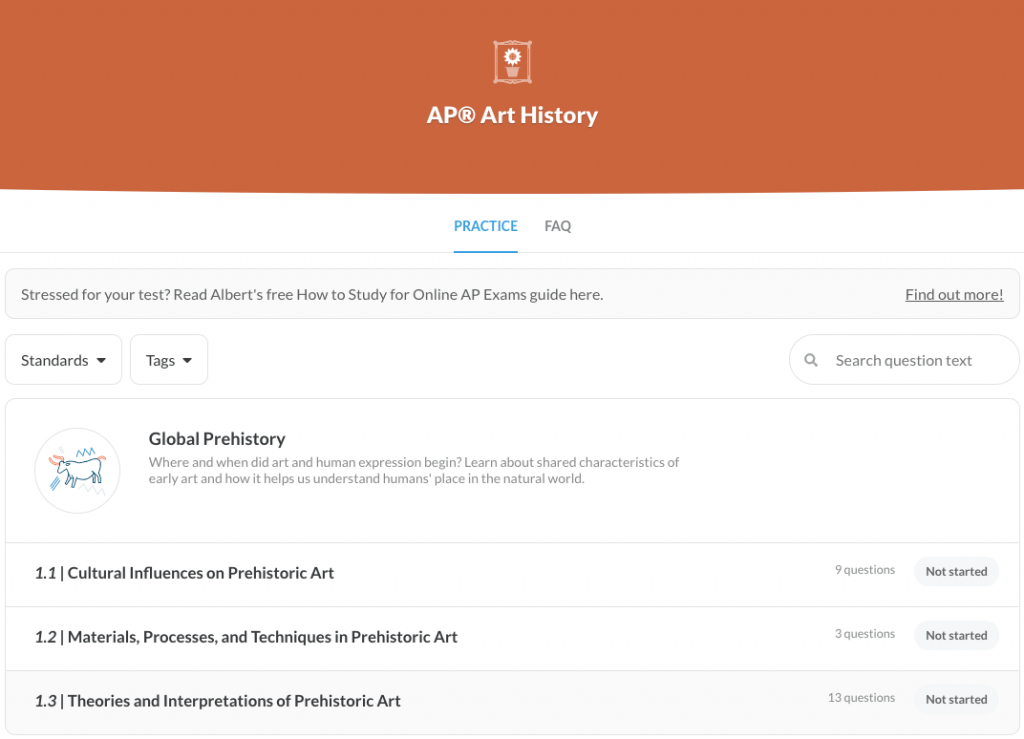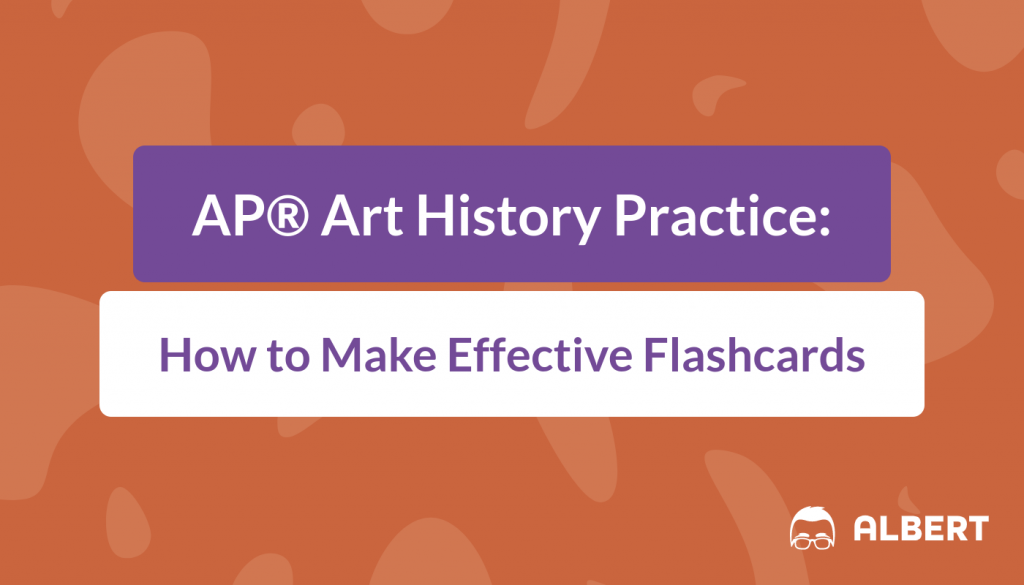You want to do well on your AP® Art History exam, and you realize that there are a lot of individual works of art that you need to remember, along with a detailed explanation that goes with each of these works. You want a fast, efficient way of reviewing all of those artworks and pertinent information whenever you have time. There is an effective way to help you organize your information in a manner that will let you study what you need to. You’ll need a few sets of AP® Art History flashcards to help you study effectively. If you follow the tips to making flashcards below, your flashcards will consolidate the vital information you need to know to do well on your AP® Art History exam. The material is broken up into meaningful sections, so you can review the flashcard as a whole, or focus on the particular information that you need to study more.
Set 1 – Basic Definitions
For every art movement, there will be terminology that you’ll have to know and be able to spell. These terms come from different languages based on the movement’s center of activity. For example, you may need to learn words like “cloisonné” or “chiaroscuro” in your AP® Art History class. You’ll need to make a flashcard for each new vocabulary word that you want to learn. Include the definition, any associated art movements, and the approximate dates of that movement. You may need to draw a basic map or diagram, when appropriate. It’s important to work with these flash cards both ways; that is, you need to know what the word means when you see it, but you also have to know how to spell the word you’re learning. Look at the definition, say the word, then spell the word out loud. Double check and make sure you’ve spelled it correctly. These words often appear in multiple choice questions or could be a medium that you’ll need to know when identifying a work of art. Consider the multiple-choice section of the AP® Art History Exam. This section is a helpful example of how you need to understand the vocabulary of the different parts of a Greek temple.
Set 2 – Individual Works of Art
AP® Art History instructors carefully choose the specific works of art that you study in class because they are relevant examples of what artists were doing at a particular time and place. For this reason, it is imperative to know these examples. Much of the AP® Art History exam will be about the works that you study in class. The free-response section of the exam requires you to know the title of the work, the artist or the culture it came from (if there is no identified artist), its date, and the materials used to make it. Include this information at the top of the flash card. Half of your multiple choice questions on the AP® exam cover individual works of art that you study in your AP® Art History class, so learning these works of art is essential. Of course, your knowledge also needs to extend beyond the primary data, so you should include information about the following ideas:
What is the work of art about?
In this section, you should write about the subject matter of the piece. For example, the work may portray a historical event, an important figure in history, or an everyday scene in urban or rural life. Be as precise as possible with names and dates here. Next, describe what you see. The free response section in the AP® Art History exam requires that at least part of your answers are based on what you see in the work of art. This section of the flashcard will help you respond to questions using details from the work of art.
Purpose – what function does the art serve?
There are many reasons that artists create art. The art may be useful, as is the case with a bed, or a cup. Consider Greek pottery: It was decorative, but also often useful in different aspects of life. Otherwise, the art may contain a religious or political message. A patron may have commissioned the artist to create a particular piece. Perhaps the artist just wanted to show the beauty of nature. It could be a combination of these reasons. You can make this section relatively brief because you will include more detailed information about this in the “why is this important” section of your flashcard.

Style – how do we know that the art was done by a specific artist or during a specific movement?
First, if the art is considered part of a particular movement, write down the name of the movement. Explain why it is a good example of what was going on in art at the time. Next, describe the stylistic elements that are unique to the artist. For example, Georges Seurat is associated with the Post-Impressionism movement because of his use of vibrant color and more everyday images. Meanwhile, his use of pointillism, using dots of unmixed color in his paintings, makes his works unique within the Post-Impressionism movement. Some artists won’t necessarily have this obvious stylistic difference. Look at the work of art and ask yourself, “How do I know that this artist created this work”? In fact, a multiple choice question on the AP® test could ask you about how you can identify the artist of a particular work.
Background – what were society and life like when the artist created the work?
Remember that art is not created in a void; it is often a reaction to what is happening in society as the artist creates it. This response to the environment comes into play in the free-response section of the AP® Art History exam, where you will use contextual evidence to answer the test questions. The information in this section of your flashcards is the foundation of the contextual evidence you need to include to respond to a free response question fully. Add a few sentences about the history surrounding the art and significant events that happened in the artist’s life. For example, death is often a major contributing factor to the creation of art. It could be on a large scale, as in a war or a revolution, or a smaller scale, like a death in the family. Other relevant factors could be on attitudes about art at that time.
Why is this work of art important?
This section of your flashcard is a synthesis and extension of the previous sections of your flashcards: subject, purpose, style, and background. It thoroughly explains the artist’s intentions about the work. On a larger scale, this also includes why the work is important in the context of art history. Your explanation should include both the artist’s intentions and historians’ analyses of the work’s importance. Significant works of art have explanations behind it that are crucial to fully understand what you are looking at. Make sure you are as detailed as possible in this section because it will have the greatest impact on your success in both the multiple-choice and free-response sections of the AP® Art History exam.
Set 3 (optional) – Philosophies of Art
You may also find it helpful to make flashcards of the major artistic movements. On these cards, you’ll write down the general ideas of the artistic movement. First, consider the progression of time. Include both what was similar AND different about the movements that happened before and after the one that is on your flashcard. You must also compare different cultures. Are there other cultures from a different time or location that have similar philosophies to art? Take a look at the free response section of the 2015 AP® Art History Exam to see how you might have to answer questions about artists’ intentions that are irrespective of the other artists or context that are direct influences on a particular artist. Note that the free response section asks for both what is similar and different about the two works of art that you choose to discuss.
These AP® Art History flashcards are a quick and convenient way to study the content of your AP® Art History class. Make flashcards for all of the works of art that you encountered in your class. All of these works are an integral part of understanding the ideas and the directions that art has taken over time and in different cultures. Making connections between ideas and understanding what is the same and different about the philosophies of the artists will give you a more comprehensive understanding of art. Art is a product of all of the different sections of information that you’ve written about on your flashcards – the subject, the purpose, the style, and the background. All of these contribute to why an artist creates and why his or her creation is important in the art world.
Need help preparing for your AP® Art History exam?

Albert has hundreds of AP® Art History practice questions, free response, and full-length practice tests to try out.
Are you a teacher or administrator interested in boosting AP® Art History student outcomes?
Learn more about our school licenses here.








